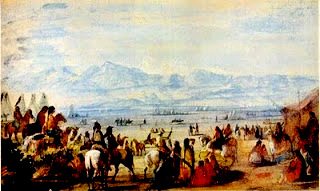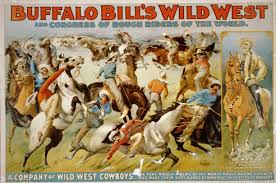How Horseback Riding shaped Wyoming’s History
Though horses originated in America, there was a 10,000 year hiatus in the history of horses on this continent because it seems that about that long ago Native Americans hunted them to extinction, along with the hairy mammoth and the giant buffalo. Fortunately before that happened, some horses had migrated across the Bering Straits to Asia where they quickly spread. History would have been very different if the Indians had domesticated and ridden horses instead of simply hunting them.

The lack of horses greatly hampered the Plains Indians in Wyoming and elsewhere because they could only depend on dogs and themselves to move their equipment from place to place and it was very difficult for a man on foot to hunt the fast moving buffalo in open country. Thus the acquisition of the horse in the early 18th century transformed their existence. After their arrival the Spaniards had long jealously guarded possession of the horse as a vital advantage in maintaining control of the vast territories they had conquered in the Americas. Their monopoly was shattered in 1680 by the Pueblo Indian revolt in Santa Fe when about a thousand horses either escaped into the wild or fell into Indian hands. These horses were some of the finest in Europe and were mostly of Arab and Andalusian blood. The wild ones found an ideal habitat in the Great Plains and multiplied quickly in numbers. The captured ones were great trade items and usually fetched a far better price than the most attractive bride.
By the 1730’s horses had reached Wyoming and vastly increased the living standards of Plains Indians there causing a population shift toward the west where, thanks to the horse, people could now hunt and move so much more easily. Of course, as with so many technological advances, horses immediately became a key player in tribal warfare which made it possible to make raids at much longer distances. They were also a most attractive and comparatively easy prize for horse thieving which was refined to a fine art and became a constant source of friction. The heyday of the Plains Indian horse culture lasted nearly a century and a half before its collapse. The famous defeat of Custer in 1876 was a last gasp in reality. The buffalo were nearly exterminated, depriving them of their livelihood, and they were ignominiously relegated to reservations.
The Indians were not the only ones to profit from the fabulous supply of magnificent wild horses which had proliferated to 3 or 4 million by the early 1800s.Trappers used them extensively during the first half of the 19th century to carry their supplies into the wilderness and to carry out the furs they collected.
These were the days of the picturesque mountain man rendezvous of the 1830s and 1840s in Wyoming and Utah. The Pony Express riders (among them Buffalo Bill), who famously carried mail in as little as seven days over the 2,000 mile trail from the Missouri River to San Francisco, used relays of these fine horses to accomplish this extraordinary feat. Later the cowboys used them for those legendary cattle drives from Texas (where there were lots of cows, but no market) to Wyoming and other states on the Great Plains. What gave these drives their impetus was the completion of the transcontinental railway in 1868 which made it possible for Texas ranchers, who had plenty of cows and little market, to ship their cows to the East Coast. Wyoming ranchers also wanted to establish herds so that they could raise cows themselves to satisfy the growing demand for beef in the East. In the peak year of 1884 it is estimated that 800,000 cows crossed the Red River between Texas and Oklahoma on their way north. The colorful era is celebrated in numerous books and songs and in movies like “Red River” and “Lonesome Dove”.
From 1883 to 1913 the Wild West Shows of Buffalo Bill Cody captivated the Western World and enthralled the crowned heads of Europe as far off as Russia. The fantastic feats of horsemanship in these fabulous shows were performed mainly on these wild horses or their descendants. The town of Cody, Wyoming today preserves these traditions of the old West more than any other place and it is now home to the magnificent Buffalo Bill Historical Museum which contains many fascinating exhibits depicting Western history.
Today horses are still a vital part of ranch life in Wyoming. It would be difficult to raise cattle on these huge areas of land, which are often inaccessible to vehicles, without horses. Today mining may be more important that ranching to the state’s economy, but ranching still dominates the culture. Rodeo is still the main attraction in most Wyoming towns. For over a century now, dude ranches in Wyoming have played an important role in preserving the old culture of the West and in offering people from all over the world a taste of what cowboy life is like. Dude ranch vacations at their best offer a more or less authentic opportunity to actually experience this tremendously appealing way of life by participating in ranch activities and working cows on horseback. Wyoming has also preserved huge areas of unspoiled wilderness and guests can take pack trips into these uninhabited areas just as the first explorers and the mountain men did. One can often travel like that for a week without seeing other humans.
Article by Bayard Fox
Additional articles on the History of Horseback Riding by Bayard Fox may be found under the following links:
History of Horseback Riding in France
History of Horseback Riding in Spain
History of Horseback Riding in Utah
History of Horseback Riding in Arizona
History of the Horse and Native American Culture



